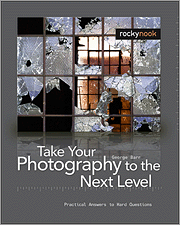
| Home |
| Join/Renew Online! |
| About NCMUG |
| Membership |
| Newsletter |
| Special Interest Groups |
| Mail Lists |
| Volunteering |
| Book Library |
| Member Sites |
| NCMUG FAQs |
| Mac FAQs |
| Contact Us |
| Site Map |

 Take Your Photography to the Next Level
Take Your Photography to the Next Level
Take Your Photography to the Next Level
Publisher: Rocky Nook
Retail Price: $39.95
Rocky Nook is a publisher of books about "cutting edge developments in photography, imaging, and technology that really matter." A partner with O'Reilly Press, Rocky Nook's inventory of books promise "More Depth to Your Field." From what I've experienced in reading "Take Your Photography to the Next Level – From Inspiration to Image," I agree with the publisher's claims.
Author George Barr is a family doctor with an interest in psychiatry, as well as a successful fine art photographer. So it follows that his writings explore the photographer's "mind's eye."
The chapters are updated and expanded writings based on essays originally featured on the Luminous Landscape website.
This book is not about photographic techniques or digital technology, nor is it the typical monograph of an individual photographer. It's definitely in a category of its own — "food for thought" that advances your creativity, develops your "eye," and makes you competent in capturing stronger images.
Barr's numerous photographs are reproduced with crisp clarity and quality of detail. I found myself surprisingly inspired by the book to go out and look at scenes with a new perspective. I want to revisit some locations that I have photographed countless times but not really "seen," to better "work the scene," explore more potential, and literally "find images" that were right in front of my lens but not captured. In this sense the book worked quite well for me.
The author shares some personal thoughts and experiences, such as the commitment required to be a professional fine art photographer. Also, how he gets over the disappointment of an editor's rejection—and how different people have different emotional reactions to the same image.
You can tell by now that this is a "right brain" book. This is clear from the chapter titles: Seeing, Finding Images, Composing, Assessing Images, Mind Games, and Finding Your Level. Although there are a few pages explaining the photographic equipment used by the author, technical details are low priority in his writing.
While I normally resist instruction on the mostly subjective process of visual composition, Mr. Barr's chapter titled Composing is free of rules of composition. Instead it provides sketch-based spatial relationship drawings to illustrate various balance and cropping examples that make the difference between a mediocre photo and a great one.
If you are an inspiring pro fine art photographer, you will be paying close attention to the content of the book, especially the captions of each beautifully reproduced photo which recount the author's opinion of the success or near-miss of his individual photos.
If you are a hobbyist, point-andshoot photographer, or just curious about this approach to seeing, you are in the target audience for the information in Take Your Photography to the Next Level. Give it a look and you may change your depth of seeing and expand your photographic thinking.
Review by NCMUG member John Hershey